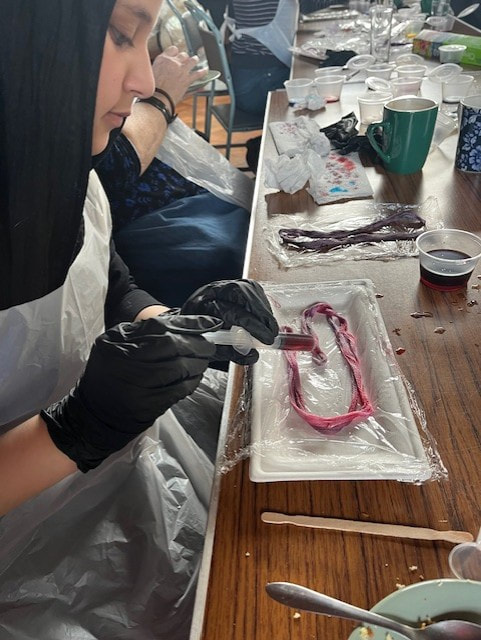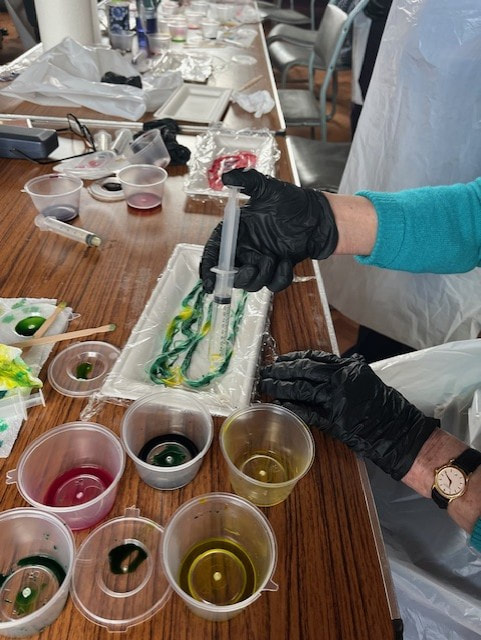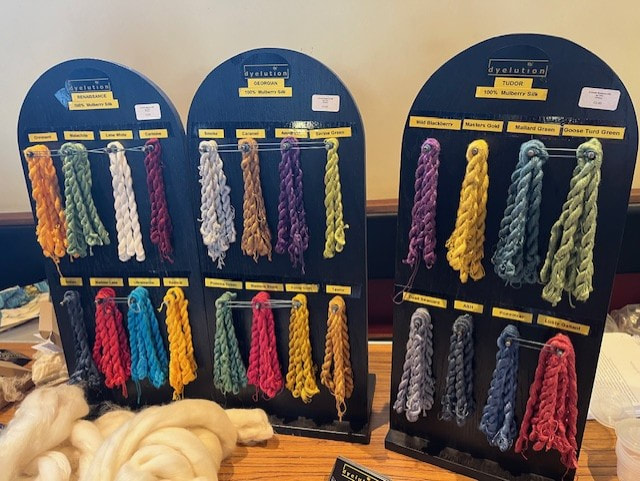|
We had a fun and informative session on Saturday with Deby Robertson from Dyelution. Deby is a local dyer and now helps to run a new guild near Studley, known as the Evesham and Redditch Guild of Weavers, Spinners and Dyers.
19 members of our guild participated in a workshop to dye small skeins of embroidery silk. Deby brought all the silks, dyes and a steamer so everyone could take home their silks. You can see some of their work below. This was the morning activity and then in the afternoon Deby gave a talk to all members of the guild (more than 30 of us) entitled The History of Silk. Deby started with telling us about the Chinese Empress in 2700BC who was sitting under a mulberry tree when a silk cocoon fell on her head and unravelled. The story goes that this was how silk was first discovered. China became the main silk growing area in these long ago times and only royalty were allowed to wear this wonderful fabric, although the law did change eventuallly and allowed anyone to wear it (however it was prohibitively expensive so probably not many did!) There is some debate over whether China was really the first country to use silk - some say it was India. Dyes first used in these ancient times included saffron, sappanwood, gallnuts, indigo and madder which sound pretty much like the main natural dyes we still use today. China was known for its vibrant colours. Silk was used as a currency too. Deby told us how the use of silk spread to Europe along the Silk Road, with monks involved in smuggling it at one time. It was certainly being used in Europe in 1100AD. Deby told us that she has researched into dyes of the Tudor, Georgian and Renaissance periods, initially because she has a friend who is involved with re-enactment. She has not only researched extensively to find the colours used at these times, but has also brought them to life by learning how to reproduce a colour palette for each era with acid dyes. She showed us her colours and the names she uses for the colours are fun! She told us some fun stories as part of her talk. Elizabeth 1st made a law to ban dyers from within 5 miles of her court as they were too smelly (they used urine as a mordant). Another monarch, James 1st wanted to grow a silk industry in England so he ordered loads of mulberry trees for the silk worms but he ordered the wrong kind of mulberry trees so that didn't work. We learnt about the different grades of silk which I found particularly interesting. Mulberry silk is the top grade that is generally available and Tussah silk is good too but not as as shiny, although as it is textured it can be easier to spin. Silk noil is the poorest grade - I have used this and now I know that it is made from the small bits that are left over from the top quality. Tussah silkworms are grown in the wild, not in sheds like mulberry silk worms. they are still farmed though -not really wild. Thank you Deby for your brilliant workshop and talk. www.dyelution.co.uk
0 Comments
|
|




 RSS Feed
RSS Feed
